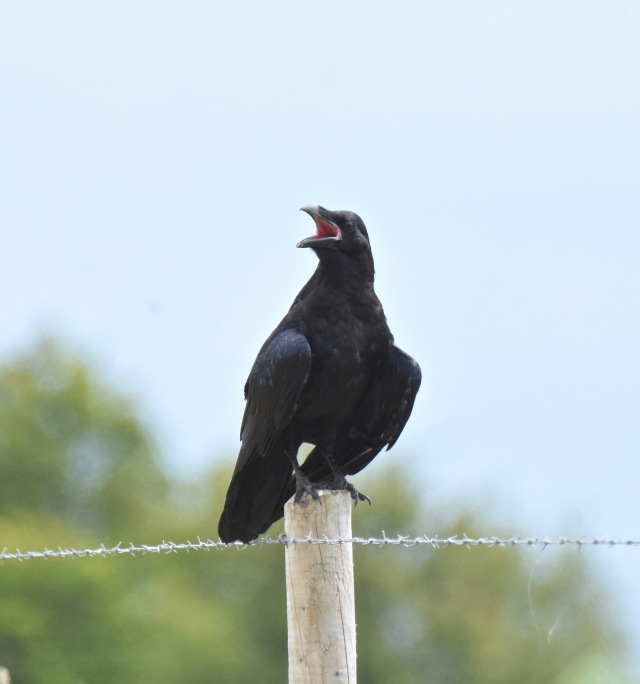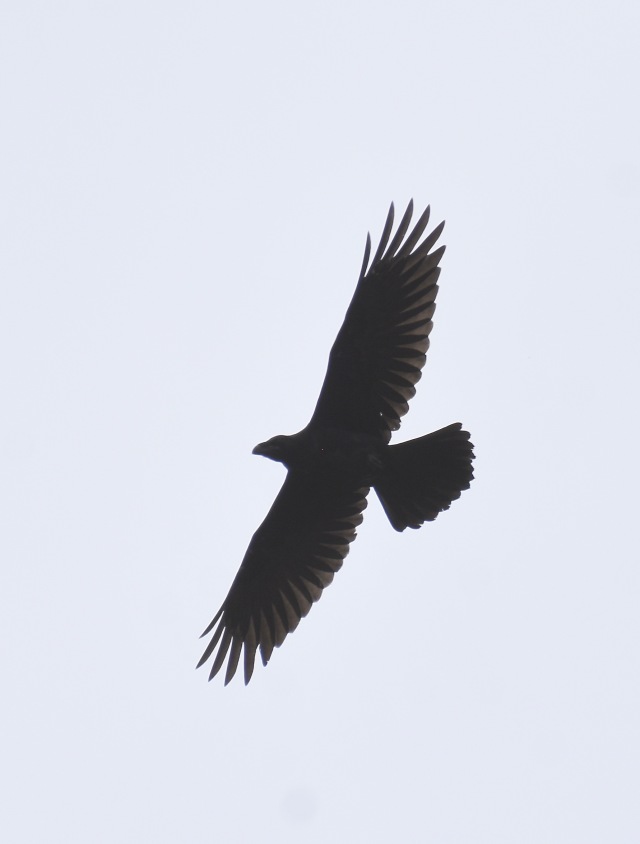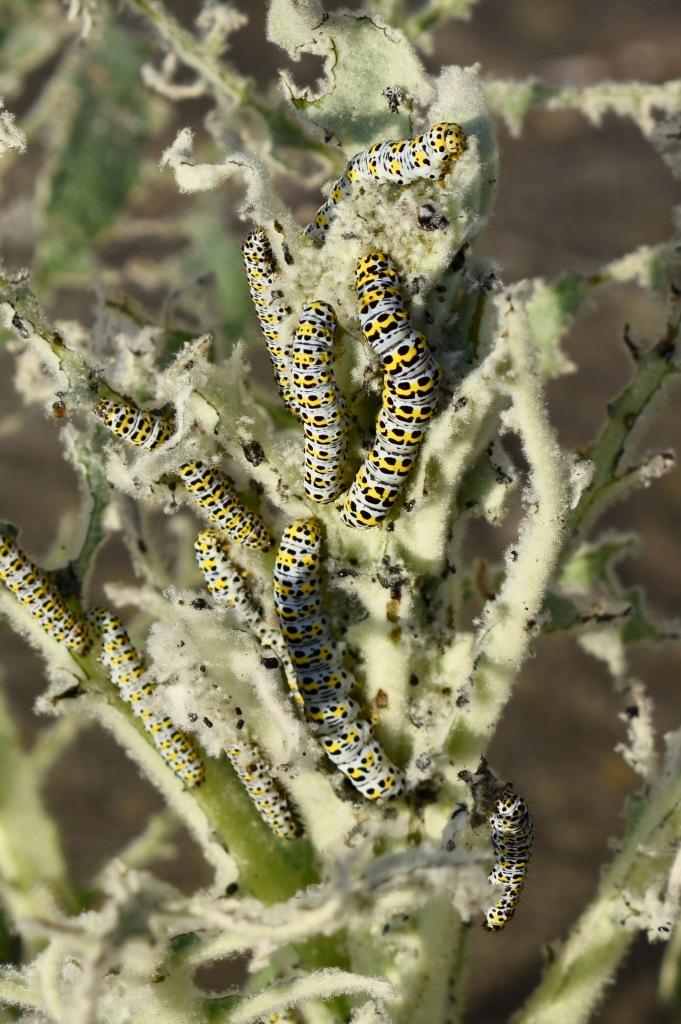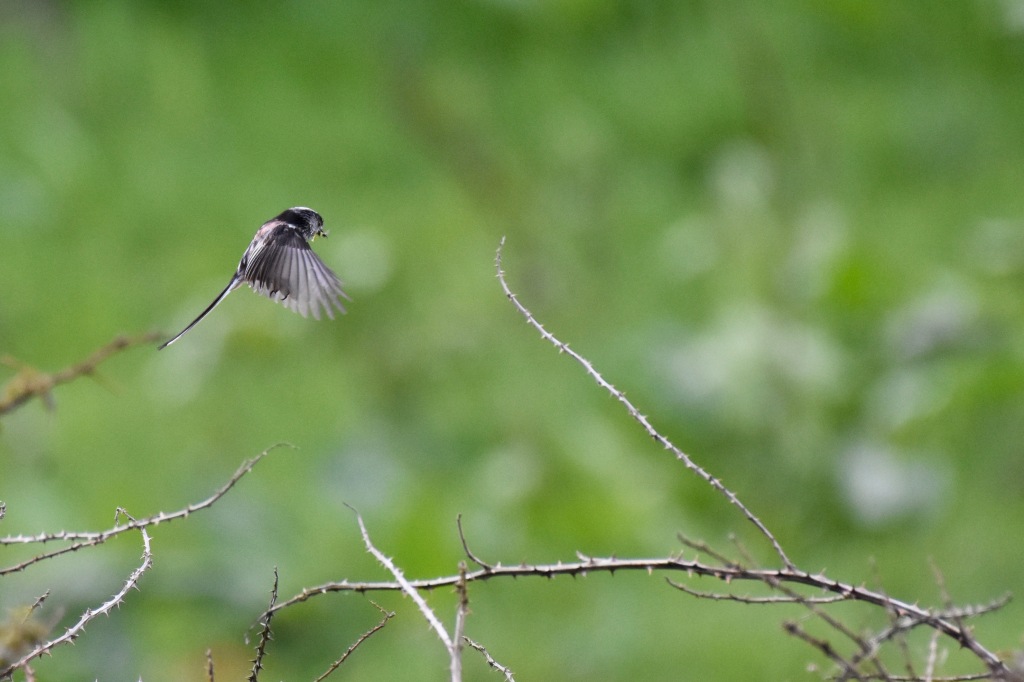Some “fledglings” are just too big for the word.

Okay, it’s recently out of its nest and yes it’s doing the wing-flappy thing and calling for its parents to feed it, but it’s just too big and dangerous-looking. For me a fledgling is a small vulnerable thing. Not a harbinger of doom with great big talons.
So I’m going to call it a young Raven.
For the time being anyway. Without hearing their call, I find it tricky differentiating with certainty between Crows and Ravens – particularly when they’re at a distance, which they usually are. There were no distinctive “honk-honk” calls from the adult birds I saw up on the plain a couple of days ago.

I managed to get one or two pictures of the them in flight and although they had longish wings – a Raven characteristic – the tail was not particularly wedge-shaped, which is also a main identifier for Ravens.
I tried to get an idea of the length of the young bird by using the 4 inch fence posts as a scale/guide. By my calculations (treat with caution) the young bird was a bit more than 21 inches long. So if the upper limit for crows is twenty inches, and the lower limit for Ravens is 21½ inches (RSPB guide), that does suggest the young bird was a Raven.

And when you compare the adult bird on the right of the above picture with the young hungry one on the left, the adult is a bit bigger still – more like twenty two inches (using the same method). But then I think the adult was a little closer in this photo so maybe that distorted things. I’m almost a hundred percent but not quite.
[CORRECTION: (posted a few weeks after this post) Glad I didn’t say I was a hundred per cent on the ID. I had assumed the fence posts were 4 inches in diameter as are the barbed wire fence posts alongside our garden, but it turned out they were more like 3.5 inches. Which of course throws out my calculations and makes it look far more likely that they were crows after all. Yet another schoolboy error in my ever lengthening dodgy record of species identification.]
Ravens have been spreading across the country from the West in recent years. I know of one or two other nests not far away (their distinctive “honk-honk” was heard) which have produced young so it looks like another good year for the species. Not all birds have done so well. I learned the other day that a lot of Great Tit and Blue Tit nests have failed this year due to a lack of caterpillars following the record-breaking cold May.
Apparently those parents that did raise young successfully often did so with the help of suet pellets from garden feeding stations. Which ties in with what I saw a few times with the fledgling Blue Tits that I photographed a couple of weeks back.

The bright pink blob turned out to be one of the suet pellets that Chantal had put out on the bird feeder. Apparently they’re made with berry juice which gives them the strong pink tinge.
The nesting season continues. With more insect life about now, current nesters will probably have a better chance of success. I’ve noticed a bullfinch standing guard in an Elder bush on the other side of the field.

He occasional drops down and goes into the brambles where I suspect the female is on their nest. I saw the male goldfinch of the pair nesting in the ivy tree doing a similar standing sentry thing for a while a month or so back. I wonder if it’s a finch thing. They seem so vulnerable to me out on display like that – no shortage of Sparrow Hawks here – but then our Goldfinches survived and raised a brood so it can’t be that bad a tactic.

I’ve now also spotted a female Whitethroat, and a delicate wee thing she is. I’m guessing she’s partnered up with the male that’s been around for a while now. She’s even more secretive and cautious than him.

The male did come close enough the other day for me to get a couple of better photos, but he was still flitting about in amongst the undergrowth, making auto-focusing difficult. Photographically challenging, but beautiful little birds.

Other species seen during the Raven walk included a Yellowhammer and a Stonechat, both singing their hearts out. I’m guessing they were proclaiming their territory or maybe trying to attract females. Whatever, they should have a better chance of success now.


So the unusually cold weather in spring this year had a devastating effect on caterpillars and the bird life that depended on them. But not all caterpillars have had a tough time of it. A couple of weeks ago I noticed an infestation of caterpillars on an Aaron’s Rod plant which had appeared in the gravel by our back door.

I initially thought they might be caterpillars of the Large White Butterfly – they had a similar yellowy green colouring – but it seemed strange that they were on an Aaron’s Rod plant, their normal food plants being of the cabbage family. But as the caterpillars grew bigger and I looked closer it became apparent they were something different. A little research revealed them to be caterpillars of the The Mullein Moth (the Aarons Rod is also know as Great Mullein). Their black and yellow colouring suggests they might be toxic which, I’m guessing, is why no hungry birds picked them off.

Apparently once the Mullein caterpillars have had their fill, they wander off and find a suitable spot to bury themselves and pupate, only reappearing as moths two or three – sometimes as many as five – years later.
After the driest and sunniest spring on record in 2020, and the coldest May on record this year, who knows what kind of a spring will await them.

















